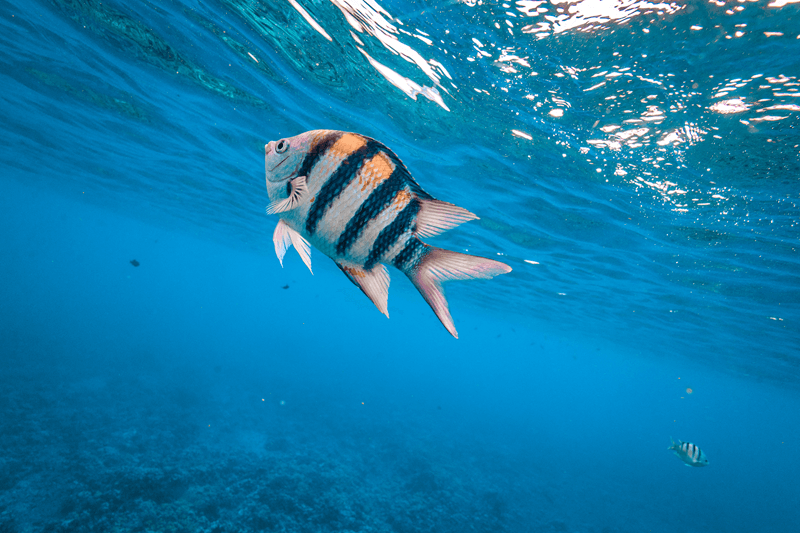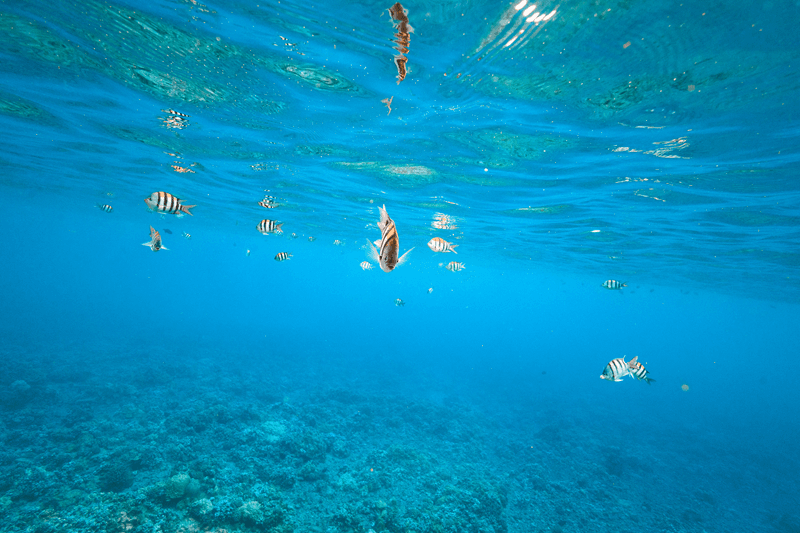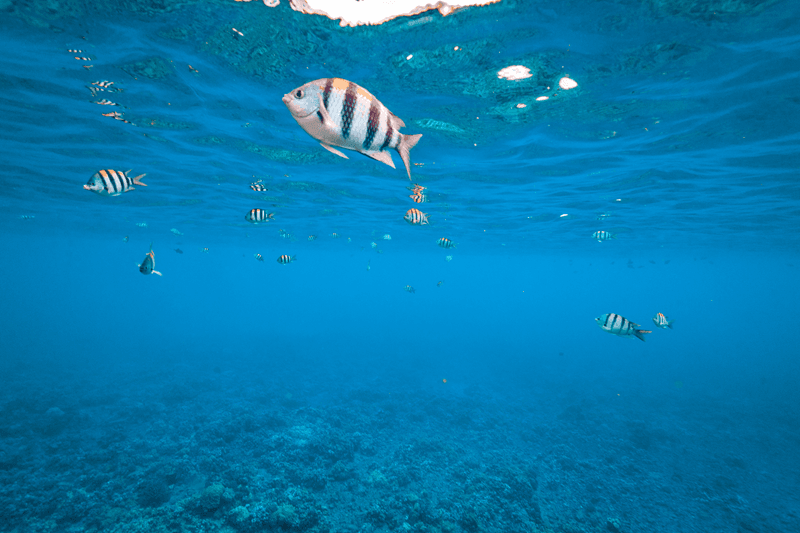Quick answer: The Hawaiian sergeant fish (Abudefduf abdominalis)—called mamo in Hawaiian—is an endemic damselfish with five vertical bars, common in Maui’s shallow reefs.
Snorkel Maui!
Dive into the vibrant underwater world of Maui, where each snorkel adventure transforms into a mesmerizing exploration of colorful coral gardens and playful marine life.
If you spend even a few minutes floating above a Maui reef, chances are you’ll see a few black-barred, deep-bodied fish gliding through the blue. That’s the Hawaiian Sergeant (Abudefduf abdominalis)—known locally as mamo—an energetic reef dweller found only in Hawaiʻi. These curious damselfish are easy to spot as they hover in small groups over rock ledges and surge channels, right where the ocean is alive with motion.
Quick ID: How to Recognize a Hawaiian Sergeant
- Look: Silver-green body with five bold vertical bars and a soft yellow wash along the belly. Their oval, deep-bodied shape is classic damselfish design. Adults grow to about 10 inches (25 cm), though most you’ll see while snorkeling around Maui are smaller juveniles.
- Behavior: By day, schools of sergeants float high above the reef, catching drifting plankton. As evening sets in, they settle back toward the reef to rest. Juveniles often begin life in tidepools before moving into deeper waters as they mature.
- Range & Depth: This fish is endemic to Hawaiʻi—found nowhere else on Earth—ranging from tidepools and nearshore shallows to about 165 feet (50 meters) deep.
- Names: In Hawaiian, it’s called mamo (from maʻomaʻo, meaning “green”). In English, you’ll hear Hawaiian Sergeant or Green Damselfish.
Where to See Them on Maui
These fish are widespread around the island, but some snorkeling spots make it easy to find them schooling close to the surface:
- Kāʻanapali / Black Rock: Schools of sergeants often patrol the rocky points and surge zones—watch for their shimmering bars in the shallows.
- Coral Gardens (Olowalu area): A great place to spot them feeding where the reef edge meets open water.
- ʻĀhihi-Kīnaʻu Natural Area Reserve (South Maui): This lava-flow coastline is teeming with fish life, including plenty of sergeants. Be sure to enter only at designated spots and follow posted rules.
- Molokini Crater – One of Maui’s best-known snorkeling destinations, Molokini’s clear waters and reef walls are perfect for spotting Hawaiian Sergeants swimming in large schools near the crater’s inner rim.
Pro Tip: Head out on a bright, calm morning—sergeants often feed near the surface when the light is high. When clouds roll in, they move a little deeper.
Courtship, Nests, and “Egg Rain” Drama
From winter through early summer, male Hawaiian Sergeants prepare for love by clearing a patch of rock for a nest. Once a female lays her eggs, the male guards them fiercely. Look closely (from a respectful distance), and you may see a purple-red patch of eggs—a sure sign of a nesting site.
If a male is startled away, opportunists like butterflyfish and triggerfish may swoop in to snack on the eggs. So please watch from a distance to avoid triggering a reef-side feeding frenzy.
Fun fact: these fish don’t just look tough—they sound tough. Males produce pops and grunts during courtship and while defending their nests, sounds you might even hear underwater on a calm day.
Similar Species: Don’t Mix Up Your “Sergeants”
- Indo-Pacific Sergeant (Abudefduf vaigiensis): A newer arrival to Hawaiʻi that sometimes hybridizes with the Hawaiian Sergeant. It shows a brighter yellow back, and its last dark bar crosses onto the tail base—unlike the Hawaiian Sergeant, whose bars usually stop before the tail.
- Blackspot Sergeant (Abudefduf sordidus, kūpīpī): Stockier and often solitary, usually found along shallow rocky shores. Look for the black spot near the upper base of the tail and a more brown-gray tone overall.
Note: Check out our Tropical Fish guide!
Snorkel Molokini Crater
Swim and snorkel with a variety of tropical fish, sea turtles, and coral reefs! Ride the 25 ft slide for extra fun!
Snorkel-Smart Ways to See Them Up Close
- Don’t feed the fish. Feeding changes their natural behavior and can upset the reef balance.
- Give nesters space. If you see a male guarding a purple patch, stay a few body lengths away so he doesn’t abandon the nest.
- Work the edges. Sergeants love ledges and surge channels where plankton flows by—drift slowly and observe.
- Time it right. Calm mornings bring better visibility and surface activity; by afternoon, they hunker closer to the reef.
Fun Facts
| Trait | Details |
|---|---|
| Family | Pomacentridae (Damselfishes) |
| Max Size | ~10 inches (25 cm) |
| Depth Range | Tidepools to 165 ft (50 m) |
| Diet | Zooplankton and some algae |
| Status | Endemic to Hawaiʻi; common statewide |
Why Locals Call Them Mamo
The Hawaiian name mamo ties back to maʻomaʻo, meaning “green,” reflecting the fish’s subtle greenish hue. For centuries, these reef sentinels have been a familiar part of Hawaiian coastal life—mentioned in stories, fishing traditions, and marine folklore.
Photo Ideas for Your Next Snorkel Adventure
📸 Try capturing:
- A clear side profile showing all five stripes and the golden belly glow.
- A small school hovering above a reef ledge.
- A male guarding a purple egg patch (shoot from distance—no flash).
FAQs
Where can I see Hawaiian sergeants on Maui?
Black Rock (Puʻu Kekaʻa), Coral Gardens, and ʻĀhihi‑Kīnaʻu; check ledges and surge channels on calm mornings, check ledges and surge channels
Are they aggressive?
Only while nesting, give guarding males several body lengths of space.
How do I tell them from the Indo‑Pacific sergeant?
Hawaiian bars usually stop before the tail base; Indo‑Pacific’s last bar often crosses it.
See Hawaiian Sergeants on a Maui Snorkeling Tour
You can spot the Hawaiian Sergeant and many other tropical fish on our all-inclusive Molokini Crater Snorkeling Tour or Afternoon Snorkeling Tour.
- Molokini Crater Snorkeling Tour: 7 AM – 12 PM, includes breakfast, lunch, and snorkeling gear.
- Afternoon Snorkeling Tour: 1 PM – 4 PM, includes lunch and snorkeling gear.
Book your next Maui snorkeling adventure and meet Maui’s striped sentry—the Hawaiian Sergeant—in its native reef home!



